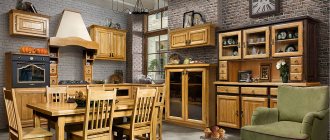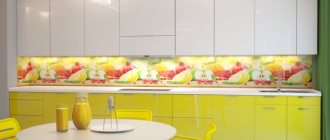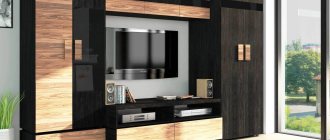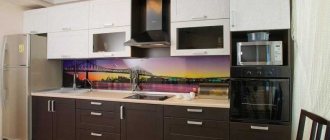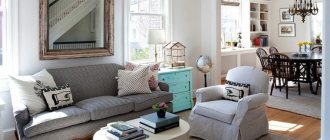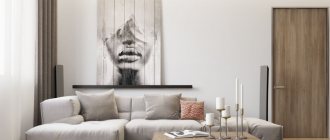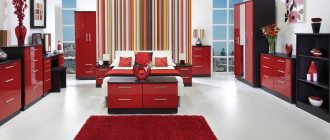Traditionally, in Moscow, all furniture for storing dishes and table linen is called buffets. This is the most numerous and varied type of cabinet furniture. Every year, at least three sideboards are restored in our workshop. Each of them is unique.
The buffet is a relatively new type of furniture. It appeared in the second half of the 19th century, during the era of historicism, which means it can be executed in any of the styles known to us. The sideboard in the Romanesque style is bulky, with an abundance of convex ornamental carvings. A buffet in the Gothic style with characteristic Gothic turrets, skyward ceilings, Gothic roses and stained glass windows. Cupboards in the Renaissance style delight with their clear proportions and exquisite ornaments of in-depth carvings. Classicism and Empire style buffets were not very popular. For the sake of fashion, the buffet of these styles looks more like a slide. But modernism, on the contrary, gave the buffet a new life. Buffets in the Art Nouveau style are chic, refined, and graceful.
A slender supply, a small or dessert buffet, serving, kitchen, dining room, huge for a large formal dining room of the 19th century, or very small for a tiny Soviet kitchen of the 60s. There are many types of buffets and there is always something to choose from. From a restoration point of view, they are complex. There was always something tasty stored in the cupboards. It spilled, woke up, left stains. Mice, cockroaches, and ants strove for deliciousness. Everyone left their traces. The cats liked to sharpen their claws on the wooden posts, and the dogs liked to gnaw on the protruding parts of the carvings. Most of the ancient buffets spent their last half century in unheated dachas, which ultimately ruined their preservation.
WE CAN RESTORE ANYTHING.
The most common type of buffet is the “old style” buffet Photos 1 and 2. These were made by small furniture cooperatives until the 30s of the 20th century. Due to their significant size, buffets usually consisted of two parts - upper and lower. Sometimes out of three. Top, middle and bottom. Sometimes the upper and middle parts were combined into one. The upper part was always made less deep than the lower, while the lower part protruded slightly forward. One shelf was usually installed inside the upper part. If the doors are glazed, it’s just a buffet. If the doors in the upper part are without glass, such a sideboard is called blind. It should be noted right away that solid buffets are in less demand than glazed ones.
The lower half of the sideboard has a large compartment with one shelf running the entire width. Closes with a double door. There are two pull-out drawers above the doors, and one or two pull-out cutting boards for slicing bread are often placed just below the countertop. The board looks like a shield or frame. In expensive buffets, the board is covered with thin marble.
The doors in simple sideboards are paneled, smooth, or decorated with overlay, recessed or sculptural carvings. The sides are usually smooth, sometimes paneled. At the top, the sideboard ends with a cornice, and in front with some kind of figured pediment. The bottom above the legs ends with a bar covered with a figured profile. Old sideboards had no empty space between the top and bottom. And in the very latest models of these simple sideboards, the back wall of the space between the top and bottom was decorated with a mirror.
Wardrobe Helga
Combined cabinet for dishes and household items – Helga. The prototype of the Soviet wall and combined cabinet furniture. Helga is a female name, similar to our Olga. This is how the GDR factory touchingly named the furniture exported to the USSR in the form of a large beautiful cabinet, consisting of a glazed central part and two symmetrical compartments with blind doors. Behind the right door were shelves for everything, and behind the left was a compartment with a crossbar for hangers and clothes. The name stuck. Now all similar Soviet furniture from the 50s, 60s, 70s is called HELGA.
The photo shows a German Helga wardrobe from the 30s. Restored in our workshop. Solid pine. Bird's eye maple veneer. Inlay – ebony (ebony). It is more like a sideboard, however, structurally, it is Helga furniture, a cabinet for dishes and things stored on hangers.
In Moscow on AVITO or SACK. Cupboard, sideboard, helga, (sometimes called a small Soviet wall) - a wide choice of any size, so buying a helga cabinet from the 60s is not difficult. It is enough to spend 2-3 weeks searching on the Internet. Not expensive. You can even receive it as a gift when you vacate an apartment for sale. Choose a German Helga wardrobe based on the photo; it should be in the best possible condition. During transportation, disassembling the cabinet with your own hands is not difficult, but some points can overshadow the purchase. Important. No smell of medicines, no dark spots on the shelves, no presence of hinges, locks with keys, handles, original glass. Check the condition of the veneer on the countertop. All this will affect the cost of restoration.
Important:
No smell of medicines, dark spots on the shelves, presence of hinges, locks with keys, handles, original glass. Check the condition of the veneer on the countertop. All this will affect the cost of restoration.
Soviet sideboard
Under the name Soviet furniture or furniture of the USSR, there is a wide variety of interior items, oddly enough, made in Germany. Trophy furniture from the 40s and 50s. GDR furniture from the 60s and 70s.
We strongly associate all these cabinets, cupboards, sideboards, cabinets, display cases and walls with the minimalism of developed socialism. The photo shows a sideboard, the restoration of which was carried out in our workshop in 2000. Currently, the cost of restoring a sideboard made of solid oak will be about 80-100 thousand rubles.
Small serving sideboard. Solid oak. Russia. 20s. Brass. Forged handles. Behind the doors there are drawers with a similar decor. The difference between a sideboard and a buffet. The sideboard has drawers behind the lower blind doors. The buffet has drawers under the tabletop - on the outside and are part of the facade.
Soviet furniture of the 60s also includes Romanian furniture. The photo shows a sideboard veneered with walnut veneer with light wood inserts. Most likely birch trees.
German sideboard
So-called trophy furniture. It is large in size and very heavy. Expensive furniture is made of solid oak and walnut. No less beautiful, but cheaper, made of pine, veneered with oak, walnut, mahogany, ash, Karelian birch. Massive thick beveled glass and marble slabs on cutting boards also add weight. On the Moscow antique market, a German sideboard, as a rule, is sold not alone, but as part of a dining room set. It comes with an extendable table, 6 or 12 chairs, a counter with a mirror, and a serving table.
You can buy a sideboard for dishes in the living room inexpensively from a photo in Moscow on the same AVITO and MESHKA. After spending 2-3 weeks searching. It is useless to look for large sideboards in antique stores. It is not profitable for stores to take them on commission. Bulky and not expensive. In addition, the product is not popular. The slide is another matter.
Soviet "canteens". Delicious nostalgia (12 photos)
Author: Dimon
18 May 2022 23:04
Community : Sweatpants & Dumplings
Tags: USSR interesting catering
24237
12
Young people tend to believe that nothing existed before they appeared. Or it was, but worse. But not always. And before “burgers” there was catering. And the fact that you can eat with your hands was invented long before the invasion of overseas taverns.
0
See all photos in the gallery
Delicious pies with jam or meat could be bought from Soviet “peddlers” on almost every corner. Or donuts! Delicious, tender, piping hot, generously sprinkled with powdered sugar.
×
0
All Soviet students remember puff tongues and shortcakes (5 kopecks each) in school canteens. And lunches for 30 kopecks.
0
And everyone also remembers the canteens in pioneer camps. And this choral ritual at the farewell dinner: “Thank you to our cooks for cooking delicious food for us.” As for me, the “cooking” was really tasty. And they looked colorful. In some incredible gauze turbans...
0
Each enterprise (and there were countless of them in the USSR) had its own canteen. Oh, these eggs with mayonnaise, sour cream in cut glasses and Olivier without meat! Steak and egg and fish day on Thursdays. Will you ever forget this? And I still haven’t learned how to cook “that” salad from fresh cabbage, it just doesn’t work. What was their secret?
0
Anyone “from the street” could dine in the factory canteen. Like any employee, he could go out during his lunch break and eat in another, “city” canteen, of which there were a great many. Even in any “Gastronom” there was a “cafeteria” where you could have a snack and drink titanium coffee with milk or a delicious milkshake for 10 kopecks.
0
In cinemas, in parks, at train stations... you could have a snack everywhere. We managed somehow without “hot dogs”. And for those who fancied themselves a gourmet, there were “Cafes”. A little more expensive than a canteen, but quite affordable for the “broad masses”. And they sold alcohol there.
0
And, of course, coffee.
0
There were also open cafes. Summer. Remember, “ice cream for the kids, flowers for the woman”?
0
Well, if you really wanted something like this... You could go to a restaurant. With 5 rubles in your pocket, you could have a good time in a mid-range restaurant. By the way, there are not very many restaurants in the USSR, but there is a wide variety, and with different price categories.
0
In any case, it will be a waiter, white tablecloths, beautiful cutlery... I won’t lie that Soviet people went to restaurants on weekdays and holidays, that’s not true. But judge the availability for yourself. Here is the menu from 1977, when the salary was 100 - 120 rubles. And the scholarship is 35 rubles.
0
Well, if life was really going well, then there was a culinary “opupei” for this case. Even a few. For example, the Prague restaurant in Moscow. Or the dream of any guest of the capital - “Seventh Heaven” in the Ostankino TV tower.
0
Unfortunately, I have nothing to say about these restaurants. Like most Muscovites, I have never been there. I bought a cake of the same name from the culinary department at the Prague restaurant from my first scholarship. But my budget wasn’t enough for “Seventh Heaven” either then, or even more so now. But I didn’t really worry about it. I had enough of other Soviet food establishments. Healthy and natural nutrition. But now this is not enough...
Source:
Related links:
- Why did the Khrushchev and Stalin buildings have windows in the bathrooms?
- Glamorous advertising in the USSR
- Do you remember? 18 eloquent photos from the dashing 90s
- Get out of the USSR. What happened to famous models from the 90s
- Through the waves of memory: 15 household items from the times of the USSR, which have long been replaced
subscribe to the “Trainiki&Dumplings” community
Tags: USSR interesting catering
Do you like to remember how things were before? Join us, let's feel nostalgic together:
420 61 359
Liked
359 4
380
Partner news
Slide with glass
The first slides were open - just shelves on which dishes were placed. At the bottom is the chassis, at the top is beautiful and expensive. The shelves are wide at the bottom and narrow at the top. The dishes were piled up. Hence the name. If the buffet and the stand are furniture for the kitchen, then the cabinet is furniture for the dining room (if there are dishes in it) or the living room, if it is intended for storing and displaying antique sets, silverware and magnificent glass to guests. The bottom of the slide is deaf. The top is glazed on three sides. Sometimes the slide is called a showcase. But the display case, unlike the slide, does not have lower blind compartments in the form of a cabinet with doors or drawers. In the second half of the 19th century, the slide glass on the facade was made bent. The slide has always been a luxury item. It’s rare for anyone to be able to buy an antique slide cheaply.
LiveInternetLiveInternet
Quote from Litizija
Read in full In your quotation book or community!
Antique china cabinets and display cases.
Cupboards: credenza, buffet, dressing room, sideboard, display cabinets.
The ancestor of all cabinets was the chest. The chest is the most important furniture, a storage of goods, a bed and a seat at the same time. Simple, convenient, universal, it was an attribute of well-being. Therefore, the fashion for chests has not passed for hundreds of years. The chest dominated the home of both noble and poor people. By the 14th century, the chest in Italy was transformed into a cassone, which was more reminiscent of a boat with carved and painted sides. Chests became a specialty of first-class artisans; Botticelli himself did not hesitate to paint them.
Cassone with the Conquest of Trebizond, 1460s The chest also became the progenitor of the credenza (cre-denza). In the Middle Ages, this was a table where food was tasted before being served. But later the credenza acquired a solid base, rested on two legs in front, and on a solid wall at the back. In the 16th century, credenzas were already built on two floors, separating them with drawers.
Victorian walnut credenza sideboard Cupboard: credenza, buffet, sideboard, display cabinets - there are many names. In ancient times, in the homes of wealthy families, such cabinets served as a demonstration podium for luxurious, exquisite tableware. Cabinets were made from valuable wood (walnut, oak, mahogany, etc.), decorated with carvings, and inlaid with precious metals.
In the 16th century, credenzas were already built on two floors, separating them with drawers. Credenza, as a rule, decorated the living room, but by the 18th century it was also placed in linen and dressing rooms (of course, in houses where they were, that is, in houses with wealth). In the second half of the 19th century, the credenza came back into fashion: bulky carved credenzas in the style of the new Renaissance again appeared in living rooms. Gold, silver or tin dishes and cutlery were stored and passed down in families by inheritance, along with the cabinet. Later, the cupboard “grew” a little due to the high legs, and it had open and closed shelves for dishes. Glass doors are another important stage in the history of cupboards, allowing wealthy people to once again demonstrate their wealth.
Circa: Florence, 1860
Antique German Sideboard Style – Renaissance Germany Material – Walnut 1880
Antique French Carved Satyr Sideboard Style – Renaissance France – Carved Walnut- 1880 ————————Empire———
Impressive Large Napoleon III Mahogany, Gilt-Bronze and Patinated Bronze Mounted Credenza after Thomiere, with winged maidendens, Napoleonic Plaques, Sphynxes and Crests. Signed: L. Dergers (Completely restored). Circa: 1870
========================sideboard========================= =
Sideboard, CA. 1853–57 Alexander Roux (American, born France, 1813–1886; firm active New York City, 1836–80) Black walnut, pine ———————Chinoiserie————————-
English Regency style (19th Cent) black lacquered Chinoiserie design 2 door sideboard cabinet with upper section
English Regency style (19/20th Cent) black lacquered Chinoiserie design small sideboard cabinet with upper section and mirror doors
Corner cupboard, Encoignure This small set of corner shelves (shown on the left of the image) is one of a pair, collected by the London military outfitter, John Jones. It was almost certainly made in France in the 1780s. ————————Dressoirs———————— Closely related to the credenza was a dressoir, in Russian a supplier, known since the early Middle Ages. This is something like a buffet with a shelf, on the shelves of which expensive dishes were placed in plain view. In France, the possession of a dress was strictly regulated by a royal decree: a baron was allowed to have a dress with two regiments, a count with three, and a duke with four. When Anne Boleyn became the wife of the English king Henry VIII (16th century), she received an extraordinary dress of twelve shelves as a gift.
A Fine French 19th/20th Century Louis XVI Style Walnut Parquetry and Gilt-Bronze Mounted Server-Commode, the D shaped cabinet with ormolu mounts and medallions with bombé side doors and marble top. Circa: Paris, 1900.
A Very Fine French 19th Century Louis XVI Style Ormolu Mounted Kingwood Parquetry Three-Door Vitrine Commode with Marble Top. Circa: 1890.
A Fine and Rare French 19th/20th Century Louis XVI Style Light-Walnut Parquetry and Gilt-Bronze Mounted Three-Door Vitrine Commode with a Brèche Violette Marble Top. Circa: Paris, 1900.
A Fine French 19th/20th Century Louis XVI Style Mahogany and Gilt-Bronze Mounted Two-Door and Two-Drawer Server/Commode Attributed to François Linke (1855-1946) with a Brêche Violette Marble Top. The central applied spray of flowers and hummingbirds is a hallmark of Linke's work. Circa: Paris, 1900.
———————-Display cabinet———— The lower part of the cabinet with three frieze drawers supported by two square-sectioned tapered legs, fronting an ormolu mounted parquetry back panel, on toupie feet. Circa: 1880.
A Rare and Unique Grand Bibliothèque, in Palissandre, Bois de Violette and Satiné Veneers by François Linke. 1901 English Georgian style (19/20th Cent) red lacquered chinoiserie design cabinet with bombe shaped base with drawers and 2 glass doors on upper section ================= Showcases==== =================== Circa: Venice, 1860 A Very Fine French 19th Century Louis XV Style Tulipwood and Gilt-Bronze Mounted Vernis Martin Decorated Vitrine Cabinet. Circa: Paris, 1880 ——————Shelves———————-
This outstanding English étagère was almost certainly a royal property of Queen Victoria, and exhibits the architectural beauty of the Victorian Sheraton style. 1875 ———————-19th century—-buffets—————————————————-Modern————————
A French Art Nouveau mahogany and walnut buffet by Paul Bec, featuring two leaded glass doors depicting leaves and flowers. Similar buffet pictured in: The Paris Salons 1895 — 1914 France, circa 1900
Cabinet-vitrine, 1899 Gustave Serrurier-Bovy (Belgian, 1858–1910) Belgian (Liège) Red narra wood, ash, copper, enamel, glass ==============Napoleon's apartment at the Louvre ============ ———————Dining room—————————
https://community.livejournal.com/interiors_ru/307529.html
Series of messages “Porcelain, ceramics, antiques”:
Part 1 - ENGLISH PORCELAIN Part 2 - Porcelain cups. Vintage porcelain Part 3 - From the porcelain collections of Capodimonte Limited Products Part 4 - Antique china cabinets and display cases. Part 5 - Porcelain swans and peacocks Part 6 - Painting on porcelain. Royal Vienna ... Part 36 - Antique shop. Transport in miniature. Part 37 - Antique Porcelain Part 38 - Ivory Carving.
Buy an antique buffet
You can buy an antique sideboard with good restoration, delivery and a 3-year guarantee in our restoration workshop. In our workshop you can restore antique, antique and vintage furniture from the 50s and 60s.
The problem with an antique sideboard is the ineradicable smell of old furniture inside the drawers and cavities closed with doors. Food, butter, jam, spices and medicines stored inside cupboards leave a trace of an unpleasant odor for a long time. The only way to get rid of it is to completely remove the old coating, sand the surface down to bare wood and apply a fresh coat of paint. Such work can only be done in a specially equipped workshop.
You can buy an inexpensive old or antique buffet on AVITO. Expensive furniture with carvings, stained glass and marquetry - at antique auctions, in salons, shops. Not necessarily, a worthy item will be expensive or a simple sideboard in poor condition will be cheap. When purchasing, it is important to take your time, understand how much this particular item is needed and how much money it will require to put it in order, in other words, how much it costs to restore a sideboard.
You can get advice from a restorer about the cost of restoring a wooden sideboard, determining the style and age of the item, its condition, the cost of repairing locks, glass, stained glass, delivery, guarantees, by calling via Whatsapp on the same phone number or our email
Sincerely, Elena Zhilina.
Restoration of paintwork
| Finishing | RUB/sq. meter |
| Waxing | 500 |
| Polishing | 1500 |
| Shellac | 2000 |
| Gilding | 3000 |
Restoration of decorative coating
| Finishing | RUB/sq. dm |
| Patination | 50 |
| painting | 200 |
| Marquetry | 500 |
| Mosaic | 1000 |
Feedback form
By sending us a completed form with photographs, as well as asking a question, you will receive complete information about the item (what it is, material, age) and the cost of restoration work. Next, the restorer will come to the site, inspect it, and determine the final price of the restoration.
The final price will not change. Departure is free.
News from Elena Zhilina's Workshop
11/15/21 A story about the profession of a modern restorer was filmed in our workshop; the program will be shown on November 24 at 18.24 on the Moscow 24
10/23/21 Mastervskaya participates in the 47th Antique Salon
, which will take place from November 23 to 28 in Gostinny Dvor
05/17/21 In the workshop on May 31, 2022. There will be an open day
. We invite specialists and lovers of antique furniture restoration. The program includes a discussion of the problem of modern furniture restoration and exchange of experience
11/15/20 Our workshop has moved to a new address, st. Rabochaya 84 building 1, Tagansky district, near the Rimskaya metro station
Antique buffet for the kitchen in Provence or country style
A sideboard cabinet is ideal for a kitchen in Provence or country style, even if its color does not match the rest of the kitchen cabinets. The top shelves of the buffet can be used to store cups, decorative plates, spice jars, tea boxes and various accessories. The spacious shelves below are perfect for storing large kitchen utensils such as cans of cereal, pots and pans. In order for the buffet to fit into the decor in the best possible way, it is better to cover it with the same tabletop as the rest of the lower cabinets in the kitchen. Vintage curtains and wall décor complete a charming, country-inspired kitchen design.
Also read: New ideas for using old furniture and other things
